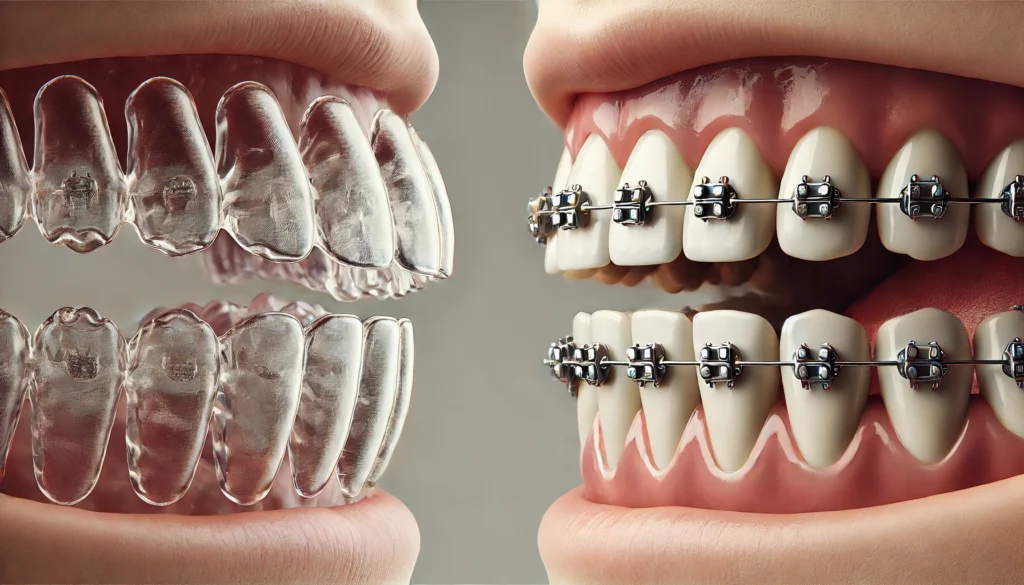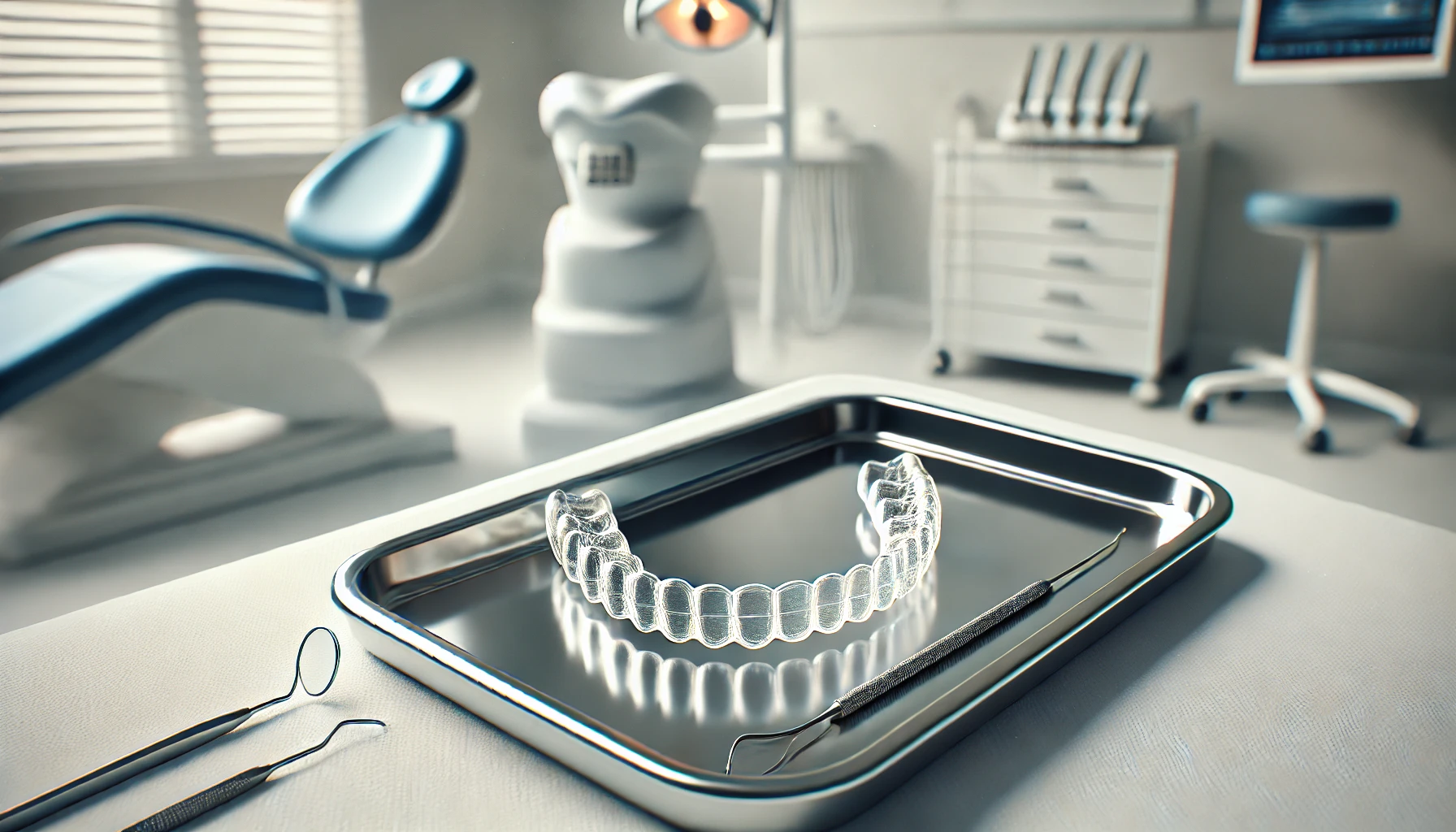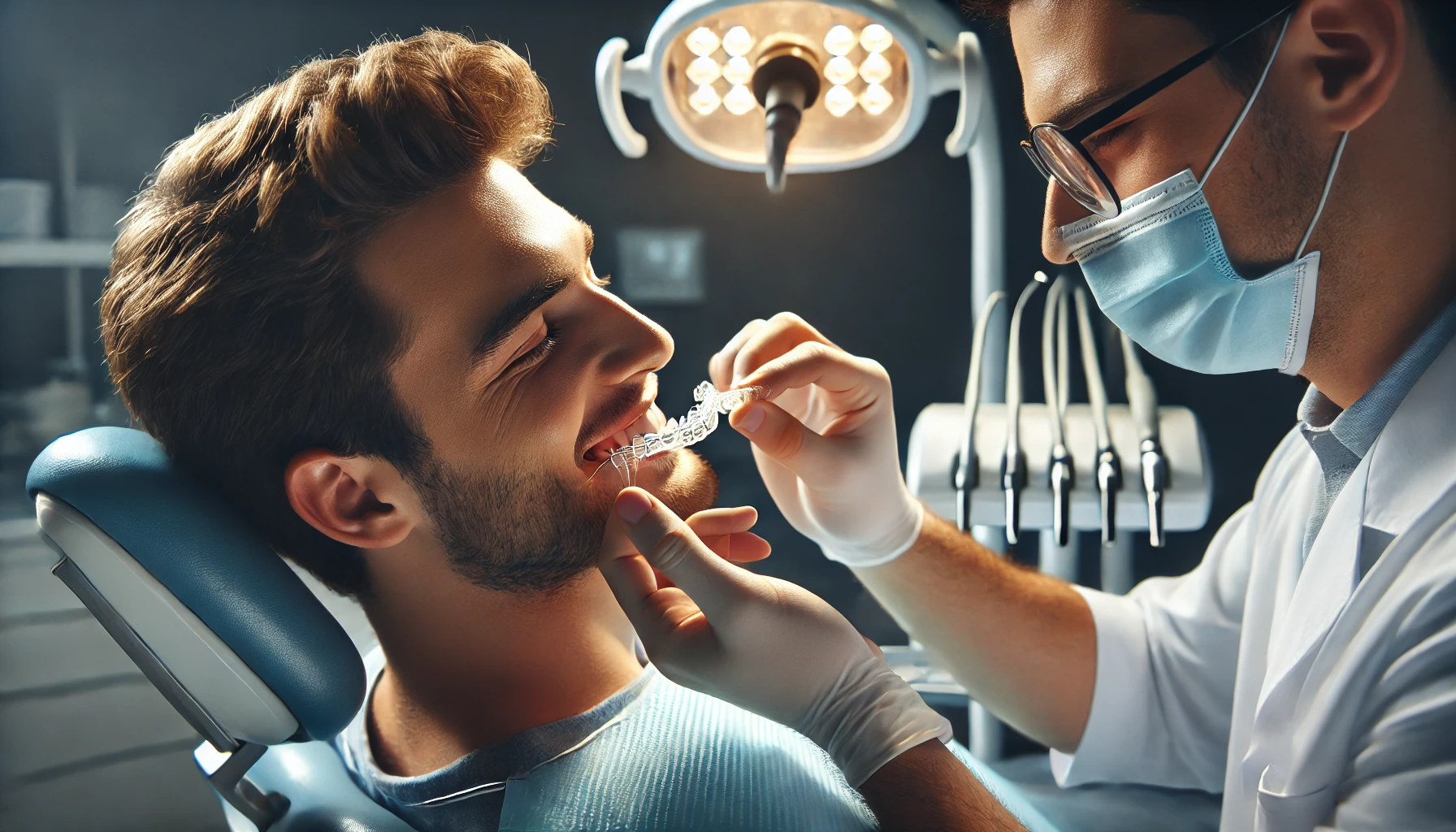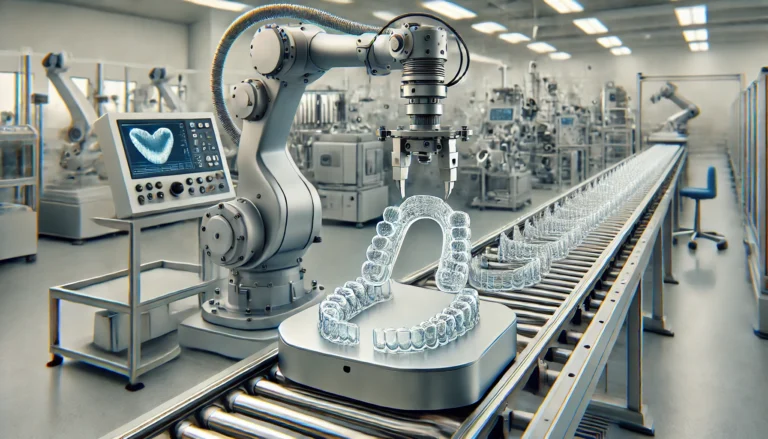
Choosing between Invisalign and traditional braces is an important decision for individuals seeking to straighten their teeth. Each option presents its own unique benefits and drawbacks, making it essential to understand the differences before making an informed choice.
This article delves into the comparison of these two orthodontic treatments, focusing on aspects such as the appearance, comfort, maintenance, and overall effectiveness. Factors like costs of Invisalign and braces, the severity of misalignment, and personal preferences will play a significant role in helping you identify the best fit for your needs in the UK.
What Are the Differences Between Invisalign vs Braces in the UK?

Understanding the differences between Invisalign and braces is crucial for anyone considering orthodontic treatment, particularly in the UK.
Invisalign is a popular choice that uses clear aligners, which are custom-made through advanced dental technology, including 3D scanning, to gradually shift teeth into the correct alignment. On the other hand, traditional braces, whether metal or ceramic, consist of brackets and wires that are bonded to the teeth.
Both treatment options aim to correct misalignment and improve the aesthetics of one’s smile, but they offer different advantages regarding comfort, maintenance, and visibility. As individuals embark on their teeth straightening journey, it is important to evaluate how each option aligns with their lifestyle and oral health goals.
1. Appearance
In terms of appearance, Invisalign presents a clear advantage with its transparent aligner trays that are virtually invisible. This feature makes it an appealing choice for both adults and teenagers who are mindful of their smile aesthetics.
The subtlety of these aligners can significantly enhance one’s confidence in social settings, allowing individuals to feel less self-conscious about their orthodontic treatment. In contrast, traditional braces often consist of noticeable metal brackets and wires, which can attract attention and, at times, invite unsolicited comments.
Many patients have remarked that opting for Invisalign allowed them to engage freely in conversations without the concern of their braces becoming the focus of attention. One client even expressed relief at no longer needing to hide their smile during photographs, while another mentioned that the clear aligners helped them maintain a professional image during important meetings.
This aspect of Invisalign not only improves the overall treatment experience but also positively affects self-esteem throughout the process.
2. Comfort
Comfort plays a vital role in the orthodontic treatment process, and numerous patients have found that Invisalign aligners offer a more comfortable experience than traditional braces. This is largely due to the fact that aligners are made from smooth plastic and are removable.
The smooth material of the aligners results in fewer sharp edges that could irritate the gums and mouth, which is a common issue for individuals wearing braces.
Because aligners can be removed during meals, patients can enjoy their favourite foods without the restrictions that often come with dental braces, which can sometimes lead to discomfort or even pain when eating certain items.
Many patients report a significant improvement in comfort with aligners, expressing relief at being able to maintain their oral hygiene routines without the additional challenge of navigating around brackets and wires. When comparing these two options, most individuals find that clear aligners lead to a more pleasant orthodontic experience.
3. Maintenance
The maintenance of orthodontic devices is crucial for achieving the desired results, and Invisalign is particularly noteworthy for its ease of maintenance. The aligners are removable, which simplifies dental hygiene practices when compared to traditional braces.
This convenience allows users to brush and floss their teeth without any obstructions, ultimately promoting better overall oral health. In contrast, individuals with braces must work around brackets and wires, which can complicate their cleaning routine and potentially lead to plaque build-up.
Both treatment options necessitate careful attention to dietary choices. For example, those with braces need to avoid sticky or hard foods that could damage their appliances, while Invisalign users have the advantage of removing their aligners before meals.
Regular follow-up appointments are essential for both methods, as they help monitor progress and make any necessary adjustments. Many user reviews suggest that consistent maintenance leads to greater satisfaction with the treatment experience, as patients feel they are making significant strides towards achieving their ideal smiles.
4. Treatment Time
Treatment duration is an important factor to consider when deciding between Invisalign and braces, as the time required to achieve alignment goals can vary significantly based on the complexity of the orthodontic issues involved.
In general, Invisalign tends to provide a quicker solution for mild to moderate misalignments, typically ranging from 6 to 18 months. On the other hand, conventional braces may require a longer commitment, often lasting between 18 to 36 months, particularly in cases involving severe alignment issues or more complex conditions that necessitate substantial adjustments.
Regular consultations with an orthodontist are crucial for both treatment options to monitor progress and make necessary adjustments. The success of each method largely depends on the patient’s commitment to wearing aligners as directed or attending scheduled appointments for adjustments.
This highlights the importance of personalised treatment plans in achieving the best possible results within the expected timeframe.
5. Effectiveness
Effectiveness plays a crucial role in any orthodontic treatment. While both Invisalign and traditional braces are well-established methods for achieving significant teeth movement and alignment, the best option often depends on the specific orthodontic challenges an individual faces.
Invisalign, for example, is particularly effective for addressing mild to moderate misalignments. Many teenagers and adults are drawn to it due to its discreet appearance and comfort, making it an appealing choice for those seeking less noticeable treatment options.
Conversely, traditional braces are well-regarded for their capability to manage more complex dental issues, such as severe overcrowding or jaw misalignment.
Research indicates that both methods have success rates exceeding 90%, though individual outcomes may vary.
A recent patient’s smile transformation story highlights this; after switching from braces to Invisalign midway through their treatment, they reported improved comfort and a newfound confidence in their smile. This underscores the importance of personalised orthodontic care tailored to each individual’s needs.
Which Is the Better Choice in the UK?

When determining whether Invisalign or traditional braces are the better option in the UK, it is important to carefully consider several factors. These include cost, availability, and personal preference, all of which can have a significant impact on the orthodontic experience.
1. Cost
Cost is frequently one of the primary concerns for patients considering orthodontic treatment. When comparing Invisalign and braces, it is important to evaluate not only the upfront costs but also factors such as insurance coverage and long-term financial implications.
Understanding these elements is crucial, as the financial commitment extends beyond the initial payments. Patients often face various expenses, which can vary based on the type of treatment selected, the complexity of their dental issues, and even the location of the orthodontic practice.
While traditional braces may have a lower initial cost, patients should take into account the possibility of additional visits for adjustments. On the other hand, Invisalign typically involves costs for a series of aligners but may necessitate fewer appointments.
Insurance coverage can play a significant role in determining overall expenses, with some dental plans offering partial reimbursement for both treatment options. Additionally, many practices provide financing options that allow patients to spread out costs over time.
Therefore, it is essential for individuals to evaluate which treatment best fits their specific financial situation.
2. Availability
The availability of Invisalign and traditional braces can vary significantly from one dental practice to another. Therefore, it is crucial for patients to conduct thorough research on local orthodontic specialists who provide these treatment options.
By seeking out professionals who offer both services, individuals can ensure a comprehensive approach to their orthodontic care. It is essential for prospective patients to schedule consultations and assessments to discuss their specific dental needs and concerns.
During these visits, the orthodontist can evaluate the patient’s unique oral structure and alignment issues, allowing for personalised treatment recommendations. This tailored approach not only enhances the effectiveness of the selected method, whether it be Invisalign or braces, but also accommodates the patient’s lifestyle and aesthetic preferences, ultimately leading to a more satisfying overall experience.
3. Severity of Misalignment
The severity of misalignment is a critical factor in determining whether Invisalign or braces will offer the most effective orthodontic treatment for an individual.
An orthodontic assessment is vital for evaluating the extent of a patient’s dental issues, which may include overbites, underbites, overcrowding, and spacing problems. During this evaluation, an orthodontist can pinpoint specific concerns, such as the degree of teeth misalignment or the positioning of the jaw.
For example, cases of misalignment that are more complex typically require traditional braces, as these provide consistent pressure to gradually shift the teeth into the desired position. In contrast, milder cases may be effectively treated with the discreet and convenient aligners offered by Invisalign.
Ultimately, a thorough understanding of the nature and severity of orthodontic issues is essential for guiding patients towards the most suitable and effective treatment options.
4. Personal Preference
Personal preference plays a significant role in the decision between Invisalign and traditional braces, as factors such as lifestyle, aesthetic concerns, and comfort levels can greatly influence this choice.
When considering orthodontic options, it is essential for patients to evaluate how these choices will integrate into their daily routines and personal aesthetics. For some individuals, the appeal of clear aligners lies not only in their discreet appearance but also in the convenience of being able to remove them during meals or special occasions.
On the other hand, traditional braces provide a proven method for addressing dental issues but may involve discomfort and noticeable hardware.
Ultimately, the success of the chosen treatment often depends on how well it aligns with a patient’s comfort and preferences, highlighting the importance of personalised choices in ensuring a fulfilling orthodontic experience.
What Are the Pros and Cons of Invisalign and Braces?

When considering orthodontic treatment options, it is important to understand the advantages and disadvantages of both Invisalign and traditional braces. This knowledge will enable you to make an informed decision that aligns with your oral health objectives and fits your lifestyle.
Pros of Invisalign
The advantages of Invisalign are quite notable, particularly its clear aligners, which provide a high level of comfort and aesthetic appeal. This makes it a favoured choice for individuals seeking a discreet option for teeth straightening.
These aligners are custom-made to fit each person’s mouth, ensuring a snug yet gentle fit that greatly reduces discomfort compared to traditional metal braces. Users frequently commend the invisibility of these aligners, allowing them to smile confidently throughout their treatment.
Additionally, the convenience of being able to remove the aligners for eating, drinking, and cleaning significantly simplifies the maintenance of oral hygiene. Many patients have shared positive experiences, emphasising how much they appreciate the flexibility of their aligners in adapting to their lifestyle—whether it involves enjoying specific foods or participating in social events without feeling self-conscious.
Cons of Invisalign
Invisalign offers numerous advantages, but it also presents some challenges that deserve consideration. One significant aspect is the need for strict adherence to the recommended wear time to ensure both effective treatment duration and optimal results.
When individuals do not follow the advice to wear their aligners for 20 to 22 hours each day, they may face delays in their progress or experience less than satisfactory outcomes, which can understandably lead to frustration. Many users find it difficult to maintain consistent wearing habits, particularly during meals or social gatherings. Research indicates that approximately 30% of patients struggle with compliance, which can sometimes extend their treatment timelines.
User testimonials reveal a range of experiences; while some individuals appreciate the convenience that Invisalign offers, others express concerns about the ease with which the aligners can be removed and subsequently forgotten. This highlights the importance of personal discipline in achieving success with this innovative orthodontic solution.
Pros of Braces
The advantages of braces lie in their proven effectiveness in addressing a wide array of orthodontic issues, ranging from severe misalignment to bite problems, making them a reliable option for many patients.
Traditional braces have consistently shown their ability not only to correct dental alignment but also to significantly enhance overall oral health. Their versatility allows them to handle complex situations that may not be effectively managed by other orthodontic alternatives.
Numerous satisfied users have shared their success stories, expressing how these braces have transformed their smiles and boosted their confidence. Dental professionals often recommend them because of their capability to achieve precise tooth movement over time, which ensures long-lasting results. This can lead to healthier bites and proper tooth alignment.
These testimonials underscore the life-changing impact traditional braces can have on individuals seeking both a more beautiful and functional smile.
Cons of Braces
On the downside, traditional braces can lead to some oral discomfort and require careful maintenance, in addition to their visible appearance, which may be a concern for certain patients.
Many patients report that wearing braces can cause irritation to the gums and cheeks, especially during the initial adjustment period. This discomfort can make eating and speaking somewhat challenging, prompting individuals to avoid certain foods or social situations.
Maintaining braces can also be quite demanding; regular visits to the orthodontist and diligent brushing and flossing are essential to prevent complications such as cavities or gum disease.
Additionally, some individuals express frustration regarding the aesthetic implications, feeling self-conscious about their smile during the treatment process. These experiences highlight the importance of carefully weighing the pros and cons when considering orthodontic options.
How to Choose Between Invisalign and Braces?

Choosing between Invisalign and braces can indeed be a bit overwhelming. However, with proper guidance from an orthodontist, you can make an informed decision that is tailored to your specific needs and treatment goals.
1. Consult with an Orthodontist
Consulting with an orthodontist is an essential first step in determining whether Invisalign or braces are the most suitable option for you. An orthodontist can provide a thorough assessment of your specific orthodontic needs.
During these visits, individuals can anticipate a comprehensive examination that may include X-rays, 3D imaging, and an in-depth discussion regarding their dental history and aesthetic goals. Preparing for this consultation can significantly enhance the overall experience; it is advisable for patients to write down any questions or concerns they have and to arrive with a clear list of their orthodontic goals.
Taking this proactive approach ensures that the orthodontist can tailor the treatment plan effectively, considering both the functional and aesthetic desires of the individual. Additionally, understanding the various options available, along with the pros and cons of each treatment, will enable patients to make informed decisions about their dental health.
2. Consider Your Budget
Considering your budget is crucial when choosing between Invisalign and braces, as the costs can vary widely, and insurance coverage can significantly impact your overall expenses.
To effectively assess the costs associated with each treatment option, it is advisable to obtain detailed quotes from dental professionals, while also factoring in any additional fees that may arise.
Many individuals tend to overlook the importance of financing options; therefore, exploring payment plans or special financing can help ease the financial burden.
It is also essential to review your insurance policy to understand which services are covered, as this may play a significant role in your decision-making process.
By comprehensively understanding all potential costs and available support, individuals can make a well-informed choice that aligns with both their dental health needs and financial comfort.
3. Evaluate Your Lifestyle
Your lifestyle plays a vital role in deciding between Invisalign and braces, as personal habits, dietary restrictions, and comfort levels can significantly affect the outcome of your orthodontic treatment.
It’s important to consider your schedule—whether it allows for regular visits to the orthodontist or if you prefer a more discreet option that is less noticeable to others. This can greatly influence your decision-making process.
For example, if you lead an active lifestyle or frequently socialise, the flexibility and near-invisibility of aligners might be more appealing, aligning with your desire for comfort and aesthetics. Conversely, for individuals who may struggle with consistently wearing aligners, traditional braces—being fixed in place—could provide a more effective solution for achieving optimal alignment.
Taking the time to reflect on how each treatment option fits into your daily life will ultimately help you make a choice that best accommodates your routine and personal comfort.
4. Think About Your Treatment Goals
When considering your treatment options, it is important to reflect on your specific goals regarding teeth straightening, as these objectives will significantly influence which choice is more effective for you.
Understanding what you hope to achieve can streamline the decision-making process. For example, if someone is looking for a discreet way to straighten their teeth, they might prioritize aesthetics. In this case, Invisalign could be the ideal choice, thanks to its clear, removable trays.
On the other hand, if a patient faces significant alignment issues or has a more complex dental structure, traditional braces may be the more suitable option, as they provide the necessary support and precision for effective treatment.
Aligning your goals with the unique advantages of each treatment method not only enhances satisfaction but often leads to more successful and timely outcomes in achieving that confident smile.
Frequently Asked Questions
What is the difference between Invisalign and braces?
Invisalign and braces are both orthodontic treatments used to straighten teeth. However, Invisalign uses clear aligners that are nearly invisible, while braces use metal brackets and wires attached to the teeth.
Which one is more suitable for adults, Invisalign or braces?
Invisalign is generally considered a better choice for adults as the clear aligners are less noticeable and can be removed for special occasions or when eating. Braces, on the other hand, are more commonly used for children and teenagers.
Which treatment is more comfortable, Invisalign or braces?
In general, Invisalign is considered more comfortable as the aligners are smooth and do not cause irritation to the inside of the mouth like braces sometimes do. However, both treatments may cause some discomfort during the adjustment period.
Which option is more affordable, Invisalign or braces?
Invisalign tends to be more expensive than braces in the UK. The cost of Invisalign can range from £2,500 to £5,500, while braces typically cost between £1,500 and £4,500. However, the cost may vary depending on the complexity of the case and the location of the dental office.
How long does each treatment take to achieve the desired results?
The treatment time for Invisalign and braces varies depending on the individual case. In general, Invisalign may take anywhere from 6 months to 18 months, while braces can take 18 months to 3 years. Your dentist or orthodontist will be able to give you a more accurate estimate after evaluating your specific needs.
Are there any restrictions on what I can eat while undergoing Invisalign or braces treatment?
With Invisalign, you can remove the aligners when eating, so there are no restrictions on what you can eat. However, with braces, certain hard or sticky foods should be avoided to prevent damaging the brackets or wires. Your orthodontist will provide you with a list of foods to steer clear of during your treatment.





